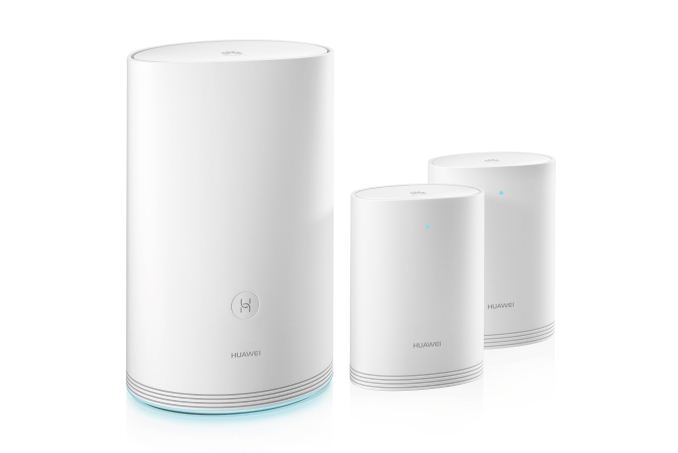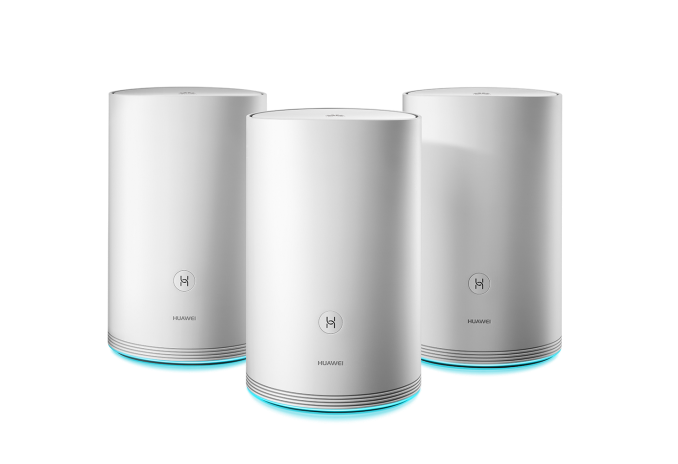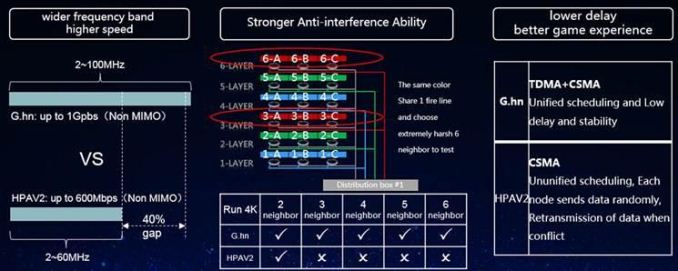Huawei Pushes G.hn Powerline Networking with the WiFi Q2 Whole-Home Wi-Fi Solution
by Ganesh T S on January 17, 2018 4:30 PM EST- Posted in
- Trade Shows
- Networking
- Huawei
- G.hn
- 802.11ac
- Wi-Fi
- Mesh Networking
- CES 2018

Mesh networking / whole-home Wi-Fi systems have seen rapid growth over the last couple of years. Almost all vendors in the consumer networking space have one or more offerings in that hot segment. At CES 2018, Huawei threw its hat into the ring with the WiFi Q2 Whole-Home Wi-Fi Solution. Huawei is no stranger to consumer networking equipment, but, their presence in the North American market is minimal.
In 2016, Huawei had introduced the Q1 single-band router with a bundled powerline-based Wi-Fi extender. It utilized HomePlug AV (200 Mbps) as the backhaul. With the WiFi Q2, Huawei is going in for a major overhaul in both the internals as well as the industrial design. The new device looks more like the Netgear Orbi kits, but, the similarities end there. Unlike other vendors who use very similar hardware for both the base / main router and the satellites, Huawei uses completely different platforms for the two. Like most of the mesh kits targeting the low-end and mid-range market, there is no dedicated wireless backhaul channel. Instead, the kit uses powerline and Wi-Fi for the base-satellite communication.
The main router is a 2x2 802.11ac + 1 Gbps G.hn PLC kit, using the Realtek RTL8197FS for the 2.4 GHz radio, and the Realtek RTL8812B for the 5 GHz radio. The G.hn chipset is Hisilicon Hi5630. This marks a departure from HomePlug AV to G.hn for the powerline communication (PLC) aspect in terms of the upgrade from Q1 to Q2.
The satellite, on the other hand, is a pure HiSilicon solution, with a HiSilicon Hi1151 to handle both 2x2 2.4 GHz and 5 GHz radio duties. The G.hn chipset from the main router is retained.
The WiFi Q2 comes in two flavors - a base and a number of satellites, or, multiple base stations (main routers). In a configuration with a base and a satellite, the backhaul is a dedicated PLC, but, a configuration with two main routers could use both PLC and the 5 GHz (867 Mbps) channel. The 5 GHz channel could be shared with clients. The system does support load balancing and can change automatically according to the connection quality of the PLC and mesh Wi-Fi. The 3-base package supports Ethernet backhaul.
Huawei WiFi Q2 Triple Base Pack
From the perspective of networking industry observers, the key update here is the shift from HomePlug to G.hn for the PLC segment. The HomePlug Powerline Alliance has stopped working on updates to the standard - there are going to be no new chipsets to improve performance and cater to the upcoming consumer / service provider requirements. On the other hand, G.hn, still has legs to go (theoretically) beyond what the best HomePlug chipsets can offer. Even though we didn't hear of any new G.hn silicon at CES 2018, there has been talk of chipsets with 2 Gbps theoretical throughputs being trialed by service providers. HiSilicon's Hi5630 is still a 1 Gbps G.hn chipset similar to the Marvell 88LX3142 / 88LX2718 used in the Arris RipCurrent products. The status of various suppliers in the G.hn market is pretty interesting - DS2 was purchased by Marvell, which has now sold the division off to MaxLinear. Copper-Gate's fate is unknown, after having been purchased by Sigma Designs, which is currently in the middle of divesting its non-Z-Wave assets after being purchased by Silicon Labs. In this context, Huawei's decision to source the PLC chipset from its subsidiary, HiSilicon, is a strategic one.
Huawei compared the performance of HiSilicon's Hi5630 with the HomePlug AV products that they were shipping. They saw some obvious advantages (similar to what we saw in our coverage of HomePlug AV vs. G.hn). Given that HomePlug AV2 is essentially a dead-end because of the absence of any roadmap from HomePlug silicon vendors, it was a no-brainer for Huawei to go with G.hn. Huawei's tests showed that G.hn's wider frequency brand, higher speed, stronger anti-interference, and lower delay made the decision much easier.
Huawei's G.hn vs. HomePlug Testing Results
At this juncture, it is clear that G.hn will be the technology of choice for PLC backhaul purposes in whole-home networking systems. However, the absence of support from high-profile vendors such as Qualcomm and Broadcom is an issue that might make other consumer networking equipment vendors avoid PLC backhaul altogether.
Coming back to the WiFi Q2, it is clear that the system is targeting the low-end to mid-range market segment, currently served by the likes of Google WiFi. That said, the product stands out from the crowd, thanks to its PLC backhaul. Pricing and other launch information for the Huawei WiFi Q2 is not available yet.
Source: Huawei












9 Comments
View All Comments
vladx - Wednesday, January 17, 2018 - link
So what's the difference between a mesh network with PLC backhaul and one without it?ganeshts - Wednesday, January 17, 2018 - link
Data from a client connected to a satellite will travel through the PLC backhaul instead of using the same Wi-Fi channel in order to get through to the base / main router.That way, the wireless channel from the satellite is dedicated to servicing clients instead of sharing time / bandwidth with the satellite - base communication
sso003 - Wednesday, January 17, 2018 - link
How far in my electrical wiring will the PLC travel? If I'm using PLC, and my neighbors are using PLC, eventually, there will be interference between signals. Unless we have a signal trap between my electrical power and the utilities connection out of the house.Also, will the utility companies be ok with us putting high frequency noise on their networks?
boeush - Wednesday, January 17, 2018 - link
I'd expect any high-frequency noise from your PLC that makes it out of your house, will be 'eaten' by the step-down transformer that connects your house to the high-voltage power line of your local grid connection, with the transformer acting as a sort of low-pass filter. Aside form which, the amplitude of the PLC signal is *very* small potatoes compared to the variable load spikes that high-power appliances inside your house - like microwave ovens, floor vacuums, computers, etc. - can load onto your house's circuits...Lolimaster - Thursday, January 18, 2018 - link
As far as I know your PLC will work on all your connected wiring as long as they share the same route/node the PLC is connected to.The PLC basically stays on all the outlets connected to the node and dies at the node cable connected to you electricity panel.
rtho782 - Thursday, January 18, 2018 - link
My general experience with powerline networking has been completely awful, I do wonder if this is partly because the UK uses ring circuits rather than radial circuits, meaning there are 2 paths for the signal causing reflection etc.asmian - Thursday, January 18, 2018 - link
It works great for me (in UK). I don't need huge amounts of network bandwidth, though. It should be a godsend for many non-technical people over wifi where they don't want to (or cannot easily) install network cabling inside a house (rented property?) so it has always amazed me that it's seen as a poor connectivity relation and doesn't get much coverage. I guess this has been exacerbated by the removal of ethernet ports from almost all new devices over pure wireless connectivity. :( It's good to hear there's a new and thriving standard. An article here covering available/new G.hn devices would be very useful.As for neighbour-to-neighbour interference mentioned above, my understanding was that the signals couldn't pass the meter connection point in a normal domestic home, so never "leaked" outside the house. Since most meters (including smartmeters) are one-way devices and aren't set up to feed energy back *out* to the grid (from solar PV or whatever) that would seem to make sense... but maybe things are set up differently outside the UK.
JFish222 - Tuesday, June 12, 2018 - link
Some of the more recent AV2000 reviews show it superior to G.hn.I'm not sure the assessments in this article are accurate given the dated comparison. Huawei has an incentive to compare itself to an older implementation . . .
Can anyone clarify on this?
johny21 - Tuesday, July 10, 2018 - link
The recent reviews are good one. https://www.facebook.com/